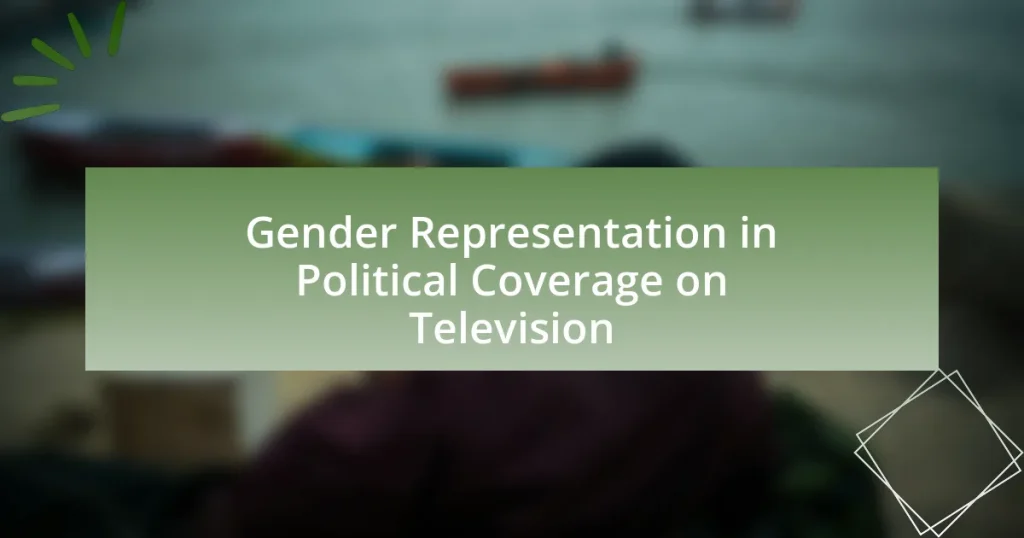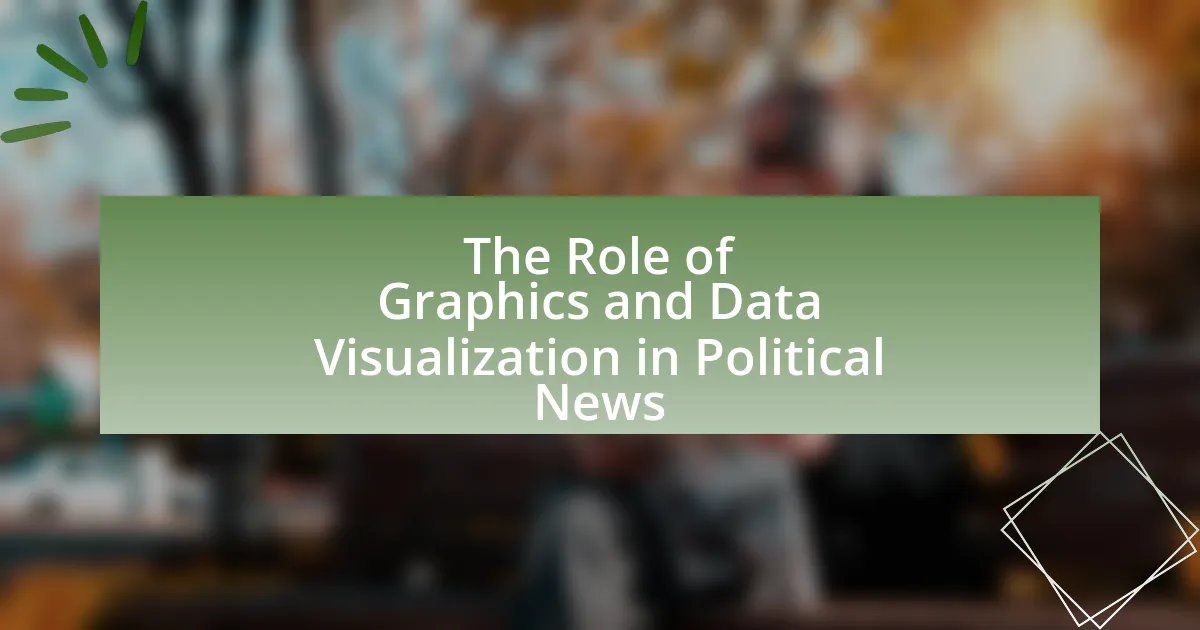Gender representation in political coverage on television refers to the visibility and portrayal of different genders, particularly women, in news segments and political commentary. Research indicates that women are often underrepresented, receiving less airtime and being depicted in stereotypical roles compared to men. This article examines the importance of gender representation in fostering diverse perspectives in political discourse, the historical trends of women’s visibility in media, and the impact of representation on public perception and voter behavior. It also discusses the challenges in measuring gender representation, the biases in reporting, and strategies for improving equitable representation in media coverage.
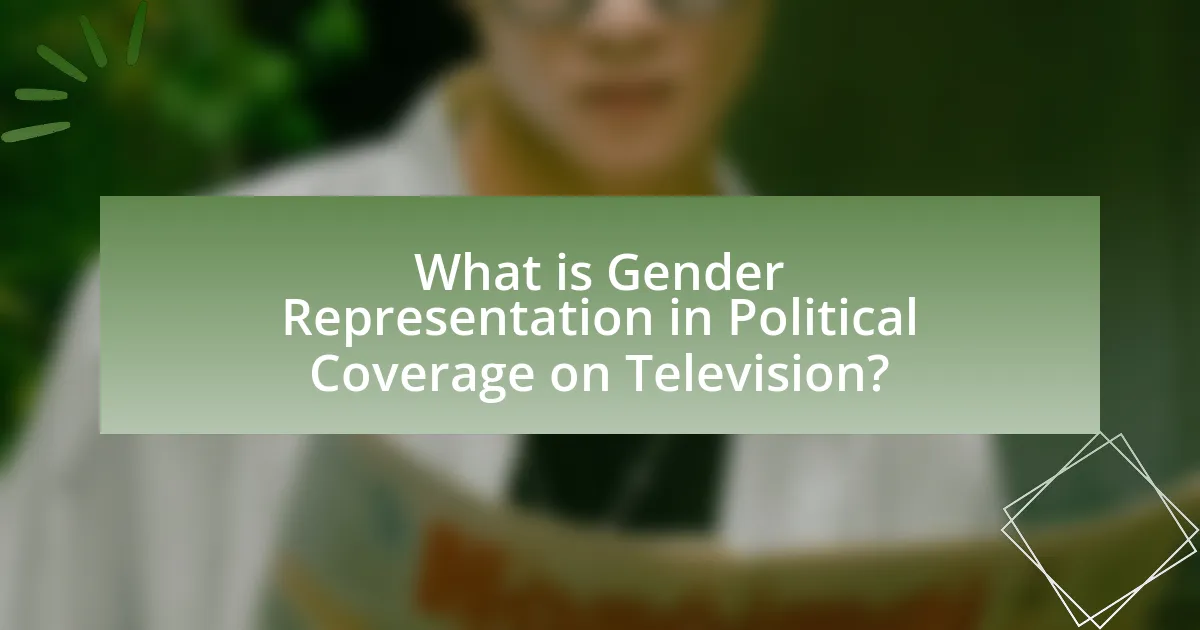
What is Gender Representation in Political Coverage on Television?
Gender representation in political coverage on television refers to the portrayal and visibility of different genders, particularly women, in news segments, political debates, and political commentary. Research indicates that women are often underrepresented in political coverage, with studies showing that female politicians receive less airtime and are frequently depicted in stereotypical roles compared to their male counterparts. For instance, a study by the Women’s Media Center found that women made up only 24% of the people heard or seen in news stories about politics. This disparity highlights the ongoing challenges in achieving equitable representation in media narratives surrounding political discourse.
Why is Gender Representation Important in Political Coverage?
Gender representation is important in political coverage because it ensures diverse perspectives and equitable representation in the political discourse. When women and marginalized genders are represented in political media, it reflects the demographics of the population and promotes inclusivity, which can lead to more comprehensive policy discussions. Research indicates that media coverage that includes diverse gender representation can influence public perception and voter behavior, as seen in studies showing that women candidates receive different media treatment compared to their male counterparts, often affecting their electoral success. Thus, gender representation in political coverage is crucial for fostering a balanced and fair political environment.
How does gender representation influence public perception of politics?
Gender representation significantly influences public perception of politics by shaping the way individuals view political efficacy and leadership. When women are visibly represented in political roles, it can enhance the perception that women are capable leaders, thereby increasing public support for female candidates. Research indicates that diverse representation leads to more inclusive policy discussions and can alter voter attitudes; for instance, a study by the American Political Science Review found that increased female representation in government correlates with higher levels of political engagement among women. This suggests that gender representation not only impacts the perception of individual politicians but also affects broader societal views on gender roles within the political sphere.
What are the historical trends in gender representation in political media?
Historical trends in gender representation in political media show a gradual increase in the visibility and participation of women over the decades. In the early 20th century, women were largely absent from political media, with limited representation in news coverage and political commentary. By the 1970s, the feminist movement began to influence media representation, leading to a slight increase in the portrayal of women in political contexts. Research indicates that by the 1990s, women began to appear more frequently as political candidates and commentators, with studies showing that women’s representation in political news coverage rose from 10% in the 1980s to approximately 25% by the late 1990s. In the 21st century, representation has continued to improve, with women holding significant political positions and being featured prominently in political media, reflecting broader societal changes and increased advocacy for gender equality.
What are the key concepts related to Gender Representation in Political Coverage?
Key concepts related to gender representation in political coverage include visibility, framing, and bias. Visibility refers to the presence and portrayal of women in political news, which has historically been lower than that of men. Framing involves how stories are presented, often emphasizing traditional gender roles or stereotypes, which can influence public perception of female politicians. Bias encompasses both overt and subtle discrimination in coverage, affecting the tone and focus of reporting on male versus female politicians. Research indicates that women are often depicted in less authoritative roles, which can undermine their credibility and influence in political discourse. For instance, a study by the Women’s Media Center found that women received only 37% of the total airtime in political news coverage, highlighting the disparity in representation.
What roles do male and female political figures play in media coverage?
Male and female political figures play distinct roles in media coverage, often influenced by societal perceptions and biases. Male political figures are frequently portrayed as authoritative and competent, receiving more airtime and positive framing in news stories. In contrast, female political figures often face scrutiny regarding their appearance and personal lives, which can overshadow their political achievements. Research by the Women’s Media Center indicates that women in politics receive only 30% of the overall media coverage, highlighting the disparity in representation. This difference in portrayal affects public perception and can influence electoral outcomes, as media narratives shape voter attitudes toward candidates.
How do stereotypes affect the portrayal of genders in political news?
Stereotypes significantly influence the portrayal of genders in political news by reinforcing traditional gender roles and biases. For instance, women in political coverage are often depicted as emotional or less competent compared to their male counterparts, which can undermine their credibility and authority. Research by the Geena Davis Institute on Gender in Media found that women are frequently portrayed in stereotypical roles, such as caregivers or in supportive positions, rather than as leaders or decision-makers. This skewed representation can perpetuate societal perceptions that women are less suited for leadership roles, ultimately affecting public opinion and voter behavior.
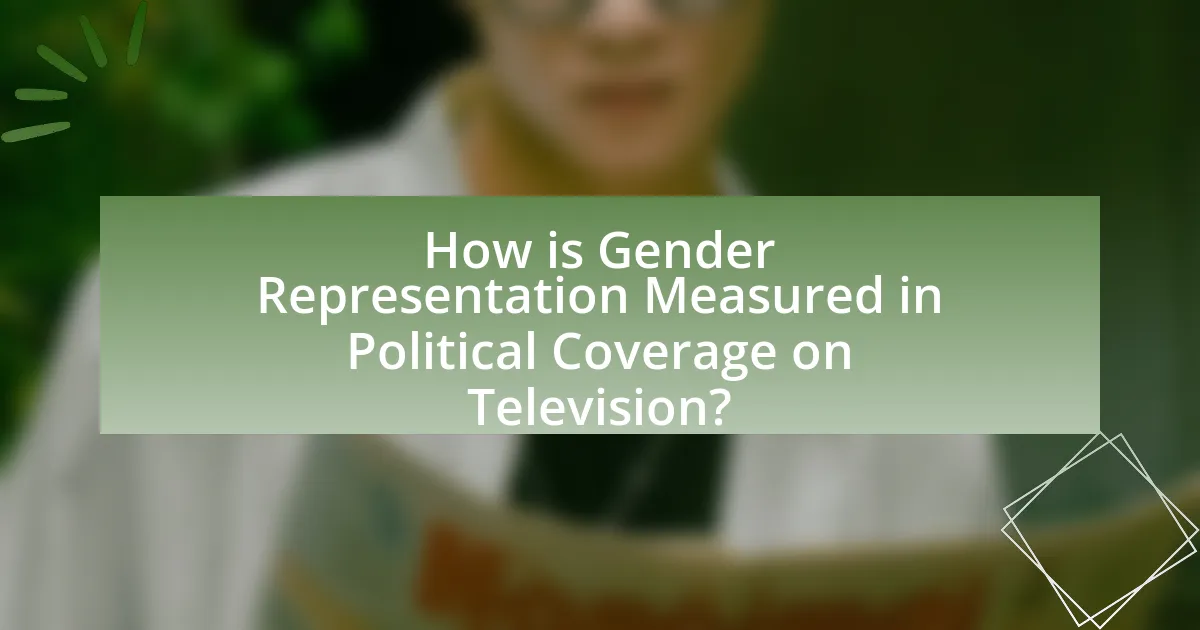
How is Gender Representation Measured in Political Coverage on Television?
Gender representation in political coverage on television is measured through quantitative and qualitative analyses of the frequency, visibility, and portrayal of different genders in news segments. Quantitative measures often include counting the number of male versus female speakers, analyzing the duration of airtime allocated to each gender, and assessing the representation of gender in various political roles. Qualitative assessments evaluate the context in which genders are presented, including the framing of issues, the tone of coverage, and the stereotypes that may be perpetuated. Research has shown that women are often underrepresented in political news, with studies indicating that female politicians receive less airtime and are portrayed in less authoritative roles compared to their male counterparts. For instance, a study by the Women’s Media Center found that women made up only 24% of the people heard or seen in news stories about politics and government.
What metrics are used to assess gender representation in media?
Metrics used to assess gender representation in media include the Bechdel Test, which evaluates whether a work features at least two named female characters who talk to each other about something other than a man. Another metric is the Gender Representation Index (GRI), which quantifies the ratio of male to female characters in media content. Additionally, the Media, Diversity, & Social Change Initiative at USC Annenberg conducts studies that analyze the gender breakdown of speaking roles and on-screen presence in films and television shows. These metrics provide concrete data on the visibility and roles of different genders in media, highlighting disparities and trends in representation.
How do quantitative measures differ from qualitative assessments?
Quantitative measures differ from qualitative assessments in that quantitative measures focus on numerical data and statistical analysis, while qualitative assessments emphasize descriptive data and subjective interpretation. For instance, in the context of gender representation in political coverage on television, quantitative measures might involve counting the number of male versus female speakers in news segments, providing a clear numerical representation of gender ratios. In contrast, qualitative assessments would analyze the tone, context, and framing of the coverage, offering insights into how gender is portrayed and perceived. This distinction is crucial for understanding the depth and breadth of gender representation in media.
What tools and methodologies are employed in gender representation studies?
Gender representation studies employ a variety of tools and methodologies, including content analysis, surveys, and qualitative interviews. Content analysis systematically evaluates media texts to quantify the representation of genders, often using coding schemes to categorize portrayals. Surveys gather audience perceptions and experiences regarding gender representation in media, providing quantitative data on public opinion. Qualitative interviews offer in-depth insights into individual experiences and interpretations of gender representation, allowing researchers to explore nuanced perspectives. These methodologies collectively enable a comprehensive understanding of gender dynamics in political coverage on television, supported by empirical data and theoretical frameworks.
What challenges exist in measuring Gender Representation in Political Coverage?
Measuring gender representation in political coverage faces several challenges, primarily due to the complexity of defining and quantifying representation. One significant challenge is the lack of standardized metrics for assessing gender representation, which leads to inconsistencies in data collection and analysis across different studies. Additionally, media bias can skew representation, as coverage may disproportionately highlight male politicians or frame female politicians in a less favorable light, impacting public perception. Research indicates that women are often portrayed in stereotypical roles, which further complicates accurate measurement. Furthermore, the intersectionality of gender with other social categories, such as race and class, adds layers of complexity, making it difficult to isolate gender representation in political discourse. These factors collectively hinder a comprehensive understanding of gender representation in political coverage.
How do biases in reporting affect measurement accuracy?
Biases in reporting significantly distort measurement accuracy by skewing the representation of data and influencing public perception. For instance, if a news outlet consistently emphasizes male politicians over female politicians, it creates a misleading narrative that may suggest a greater male presence in political discourse than actually exists. Research by the Geena Davis Institute on Gender in Media found that women are often underrepresented in news coverage, which can lead to a misinformed public and policymakers who may underestimate the importance of gender diversity in political representation. This underrepresentation directly affects the accuracy of measurements related to gender equity in politics, as it fails to reflect the true demographic landscape.
What limitations do researchers face in data collection?
Researchers face several limitations in data collection, including access to reliable sources, sample size constraints, and potential biases in data interpretation. Access to reliable sources can be hindered by the availability of data, as some political coverage may not be adequately documented or archived. Sample size constraints often arise from the difficulty in obtaining a representative sample of television coverage, which can lead to skewed results. Additionally, biases in data interpretation can occur due to the subjective nature of analyzing gender representation, where researchers may inadvertently impose their own perspectives on the data. These limitations can significantly impact the validity and reliability of research findings in the context of gender representation in political coverage on television.
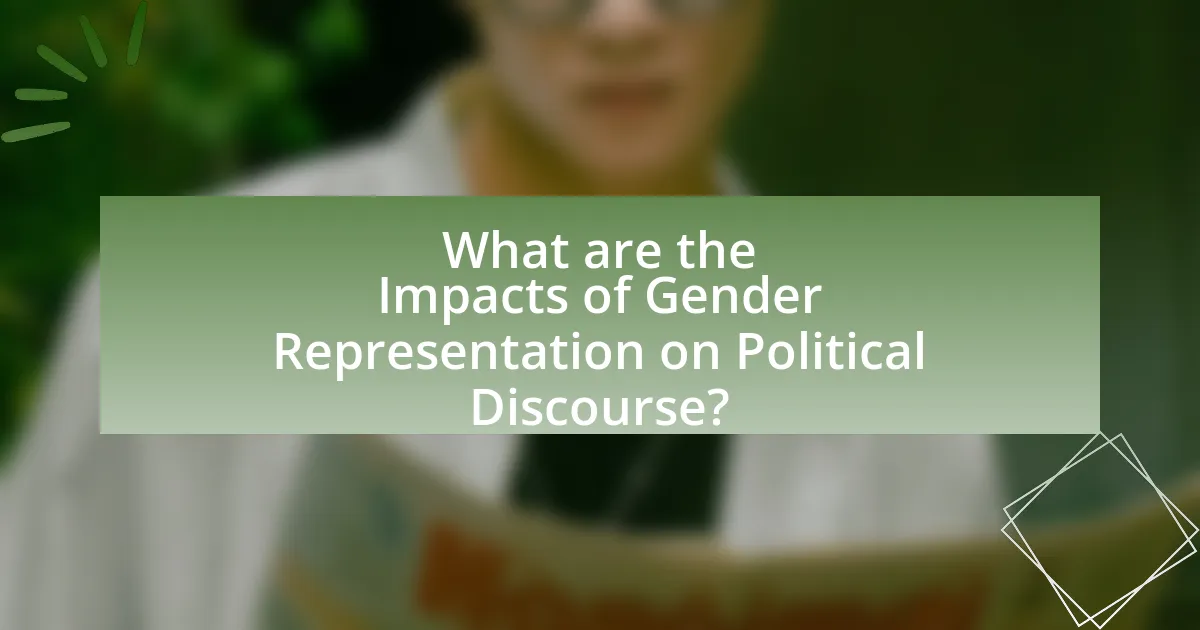
What are the Impacts of Gender Representation on Political Discourse?
Gender representation significantly impacts political discourse by shaping public perceptions and influencing policy discussions. Research indicates that increased visibility of women in political roles leads to more inclusive conversations and diverse viewpoints, which can enhance democratic engagement. For instance, a study by the American Political Science Review found that female politicians often prioritize issues such as healthcare and education, which may be underrepresented in male-dominated discussions. Furthermore, gender representation can alter the tone and style of political communication, as women may employ more collaborative and consensus-building approaches compared to their male counterparts. This shift can foster a more constructive political environment, ultimately affecting voter engagement and policy outcomes.
How does gender representation affect audience engagement with political content?
Gender representation significantly affects audience engagement with political content by influencing perceptions of credibility and relatability. Research indicates that diverse gender representation in political coverage can enhance viewer interest and trust, as audiences are more likely to engage with content that reflects their own identities and experiences. For instance, a study published in the Journal of Communication found that women are more likely to engage with political content when female politicians are prominently featured, as this representation fosters a sense of inclusion and relevance. Additionally, male viewers also show increased engagement when women are represented, as it challenges traditional gender norms and promotes a broader understanding of political discourse. Thus, effective gender representation in political content not only attracts a wider audience but also deepens their engagement with the material presented.
What role does gender representation play in shaping political opinions?
Gender representation significantly influences political opinions by affecting how individuals perceive political issues and candidates. Research indicates that diverse representation in media leads to a broader understanding of political perspectives, as audiences are exposed to varied viewpoints that resonate with different demographics. For instance, a study by the Geena Davis Institute on Gender in Media found that when women are portrayed in leadership roles on television, it positively impacts viewers’ perceptions of women’s capabilities in politics, thereby shaping their political opinions and engagement. This demonstrates that gender representation not only reflects societal norms but also actively contributes to the formation of political attitudes and behaviors among the audience.
How do different demographics respond to gender representation in political coverage?
Different demographics respond to gender representation in political coverage in varied ways, influenced by factors such as age, gender, and political affiliation. Research indicates that women and younger audiences tend to favor increased representation of female politicians in media, as they perceive it as a step towards gender equality and inclusivity. For instance, a study by the Pew Research Center found that 63% of women believe that more women in political coverage would positively impact public perception of women’s roles in leadership. Conversely, older demographics and certain political groups may exhibit less enthusiasm for gender representation, often prioritizing traditional narratives and established male figures in politics. This divergence highlights the complex relationship between demographic factors and perceptions of gender representation in political media.
What are the implications of gender representation for future political coverage?
Gender representation significantly influences future political coverage by shaping public perception and engagement in the political process. When media outlets prioritize diverse gender representation, they can challenge stereotypes and promote a more inclusive narrative, which has been shown to enhance voter participation among underrepresented groups. For instance, studies indicate that increased visibility of women in political roles correlates with higher political interest and engagement among female audiences. Furthermore, equitable representation can lead to more comprehensive coverage of issues that affect different genders, ultimately fostering a more informed electorate.
How can media organizations improve gender representation in their coverage?
Media organizations can improve gender representation in their coverage by actively ensuring balanced representation of women and men in news stories and decision-making roles. This can be achieved by implementing policies that mandate equal opportunities for female sources and experts, thereby addressing the historical underrepresentation of women in media narratives. Research indicates that diverse newsrooms produce more inclusive content; for instance, a study by the Women’s Media Center found that women comprised only 24% of the people heard or read about in mainstream media. By prioritizing gender diversity in sourcing and staffing, media organizations can create a more equitable representation that reflects the demographics of society.
What best practices can be adopted to ensure equitable representation?
To ensure equitable representation in gender representation within political coverage on television, media organizations should adopt practices such as implementing diversity quotas, conducting regular audits of representation, and providing training on gender sensitivity for journalists. Diversity quotas can help ensure that a balanced number of male and female voices are included in political discussions, which is supported by studies indicating that diverse teams lead to more comprehensive coverage. Regular audits of representation can identify gaps and areas for improvement, allowing organizations to adjust their practices accordingly. Training on gender sensitivity equips journalists with the skills to report on gender issues more effectively, fostering a more inclusive media environment.
What strategies can viewers employ to critically assess Gender Representation in Political Coverage?
Viewers can employ several strategies to critically assess gender representation in political coverage. First, they should analyze the language used in reporting, noting whether it reinforces stereotypes or promotes equality. Research indicates that media language can significantly influence public perception of gender roles (Smith et al., 2018).
Second, viewers should evaluate the diversity of voices presented in political discussions, considering whether women and marginalized genders are given equal airtime and representation in expert commentary. Studies show that women are often underrepresented in political news segments, which can skew public understanding of gender issues (Davis, 2020).
Third, viewers can compare coverage across different media outlets to identify biases or disparities in how genders are portrayed. This comparative analysis can reveal patterns of representation that may not be apparent when consuming content from a single source.
Lastly, engaging in discussions with others about the coverage can help viewers gain different perspectives and challenge their own biases, fostering a more nuanced understanding of gender representation in political contexts.
